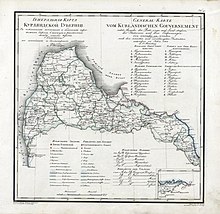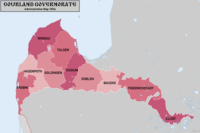| Courland Governorate | |||||||||
|---|---|---|---|---|---|---|---|---|---|
| Governorate of the Russian Empire | |||||||||
| 1795–1918 | |||||||||
 Flag
Flag
 Coat of arms
Coat of arms
| |||||||||
 Location in the Russian Empire The Governorate in 1821 (Russian/German) | |||||||||
| Capital | Mitau | ||||||||
| Population | |||||||||
| • 1897 | 674,034 | ||||||||
| History | |||||||||
| • Partition of Poland | 28 March 1795 | ||||||||
| • German occupation | 1918 | ||||||||
| • Treaty of Brest-Litovsk | 1918 | ||||||||
 Subdivisions or uyezds of Courland Governorate | |||||||||
| Political subdivisions | 9 | ||||||||
| |||||||||
| Today part of | Latvia Lithuania | ||||||||
| Part of a series on the |
|---|
| History of Latvia |
 |
| Ancient Latvia |
| Middle Ages |
| Early modern period |
| National Awakening |
Modern Latvia
|
| Chronology |
|
|
Courland Governorate, also known as the Province of Courland or Governorate of Kurland, and known from 1795 to 1796 as the Viceroyalty of Courland, was an administrative-territorial unit (guberniya) and one of the Baltic governorates of the Russian Empire. Its area roughly corresponded to Kurzeme, Zemgale and Sēlija of modern-day Latvia.

History
The governorate was created in 1795 out of the territory of the Duchy of Courland and Semigallia, which was incorporated into the Russian Empire as the Viceroyalty of Courland with its capital at Mitau (now Jelgava) following the third partition of the Polish–Lithuanian Commonwealth.
In 1915, during the World War I Courland was occupied by the German Empire. With the Treaty of Brest-Litovsk on 3 March 1918, Bolshevik Russia accepted the loss of the Courland Governorate. After an attempt to reestablish the Duchy of Courland and Semigallia as a client state of the German Empire, Courland was united with Vidzeme and Latgale to form the Republic of Latvia on 18 November 1918.
Geography
The governorate was bounded in the north by the Baltic Sea, the Gulf of Riga and the Governorate of Livonia; west by the Baltic Sea; south by the Vilna Governorate and Prussia and east by the Vitebsk Governorate and Minsk Governorate. The population in 1846 was estimated at 553,300.
It was situated between 55°41' and 57°451⁄2' N. Of its total border of 1,260 versts (1,344 km), the sea border is 320 versts (341 km). The border with Prussia is only 6 versts (6.4 km) long and lacks natural boundaries.
The surface area of the province is 26,112 square versts (29,716 km).
Subdivisions
After the annexation to the Russian Empire, the Kurzeme Governorate united the lands of the Duchy of Courland and Semigallia and the Piltene district, both of which retained their previous administrative divisions.
After the administrative reform of 1819, the area of Pilten was incorporated into the territory of the province as the district of Windau (Hauptmannschaft Windau) and the district of Hasenpoth (Hauptmannschaft Hasenpoth). After the reform of 1819, the castle lord of Kandava moved to Talsi. The area of Palanga up to the Prussian border was also added to the Kurzeme province from the Vilna Governorate. The province was divided into ten districts, or Hauptmannschaft, whose administrative authorities were located in the towns of the same name, with the exception of Talsi and Ilūkste, which had only the rights of towns. Each district had its own court with a local police force. Until 1864, every two districts were merged into Oberhauptmannschaft, which contained the Oberhauptmann and the Evangelical Lutheran Church dean's districts under the authority of the Oberhofgericht (Court of the Governor's Court).
The counties of the governorate were:
| County | Administrative center
or / and the most populated city |
Population | Arms of County Town | Area | Population (1897 census) | |
|---|---|---|---|---|---|---|
| Name in German | Name in Russian | 1897 | ||||
| Bauske | Баускій | Bauske (Bausk) |
6.544 | 2,097.4 km (809.8 sq mi) |
50,547 | |
| Windau | Виндавскій | Windau (Vindau) |
7.127 | 3,136.4 km (1,211.0 sq mi) |
48,275 | |
| Hasenpoth | Газенпотскій | Harsenpoth (Gazenpot) |
3.340 | 2,506 km (968 sq mi) |
53,209 | |
| Goldingen | Гольдингенскій | Goldingen | 9.720 | 3,276.4 km (1,265.0 sq mi) |
66,335 | |
| Grobin | Гробинскій | Grobin | 1.490 | 4,685.4 km (1,809.0 sq mi) |
110,878 | |
| Liepāja (Libava) | 64.489 | |||||
| Illukst | Иллукстскій | Illukst | 3.652 | 2,249.7 km (868.6 sq mi) |
66,461 | |
| Doblen | Митавскій (Добленскій) |
Mitau (Mitava) |
35.131 | 2,847.2 km (1,099.3 sq mi) |
101,310 | |
| Talsen | Тальсенскій | Talsen | 4.200 | 3,151.1 km (1,216.6 sq mi) |
61,148 | |
| Tukkum | Туккумскій | Tukkum | 7.555 | 2,262.6 km (873.6 sq mi) |
51,076 | |
| Friedrichstadt | Фридрихштадтскій | Friedrichstadt (Fridrikhshtadt) |
5.175 | 3,504.2 km (1,353.0 sq mi) |
64,795 | |
| Jēkabspils (Jakobstadt) | 5.829 | |||||
Law
The highest court is the Courts of Kurland (Kurländisches Oberhofgericht), the courts of appeal are the Higher Hauptmanns Courts (Oberhauptmannsgericht), The courts of first instance are the Hauptmannsgericht, the county courts (kreisgericht) for the peasantry, and the lowest level of the court system for the peasantry are the parish courts (Gemeindegericht).
Administration

The province of Courland was governed by a governor appointed by the emperor. The representative body of local government was the Landtag (Kurländischer Landtag), which consisted of parish commissioners (Kirchspielsbevollmächtigter, Konvokant) elected by the parishes (Landtagskirchspiel, Parochie) by parish assemblies (Kirchspielsversammlung), In the parish meetings (Kirchspielsversammlung) all large landowners of the parish could participate, the executive body - a noble committee headed by a land commissioner (Landesbevollmächtige) was elected to conduct its sessions.
The residence of the governors was in Jelgava Castle, where the governorate's administrative offices were also located. During the existence of the Baltic Governorate (1801-1876, 1906–1909), the governors of Kurzeme were subordinate to the governor-general of the Baltic Provinces (German: Generalgouverneur der Ostseeprovinzen)., who resided in the Riga Castle.
Until Russification, almost all governors of Courland were German-Baltic noblemen. Until then, the language of administration in the highest authorities and courts of the province was German, but in the parish courts, according to the Courland peasant laws, the records were also kept in Latvian.
- 1795 – 1796 Baron Peter Ludwig von der Pahlen (temporary governor-general of Courland and Pilten)
- 1796 – 1798 Count Gustav Matthias Jakob von der Wenge genannt Lambsdorff
- 1798 – 1800 Baron Wilhelm Carl Heinrich von der Oest genannt Driesen
- 1800 – 1808 Nikolay Ivanovich Arsenyev
- 1808 Jakob Maximilian von Brieskorn (acting governor on 18–21 May 1812)
- 1808 – 1811 Baron Jan Willem Hogguer
- 1811 Jakob Maximilian von Brieskorn (acting governor in August–September 1812)
- 1811 – 1816 Count Friedrich Wilhelm von Sivers (1748–1823) (in exile in Riga during Napoleonic invasion of Courland in July–December 1812)
- 1812 Jules de Chambaudoin and Charles de Montigny (French intendants of Courland, Semigallia and Pilten on 1 August-8 October 1812)
- 1812 Jacques David Martin (French governor-general of Courland on 8 October-20 December 1812)
- 1816 – 1824 Emannuel von Stanecke
- 1824 – 1827 Paul Theodor von Hahn (1793–1862)
- 1827 – 1853 Christoph Engelbrecht von Brevern
- 1853 Aleksandr Petrovich Beklemishev (acting governor on 10 May–14 June 1853)
- 1853 – 1858 Pyotr Aleksandrovich Valuyev
- 1858 Julius von Cube [de] (acting governor on 10–21 May 1858)
- 1858 – 1868 Johann von Brevern
- 1868 – 1885 Paul Frommhold Ignatius von Lilienfeld-Toal
- 1885 Aleksandr Alekseyevich Manyos
- 1885 – 1888 Konstantin Ivanovich Pashchenko
- 1888 – 1891 Dmitry Sergeyevich Sipyagin
- 1891 – 1905 Dmitry Dmitriyevich Sverbeyev
- 1905 – 1906 Woldemar Alexander Valerian von Boeckmann
- 1906 – 1910 Leonid Mikhailovich Knyazev
- 1910 Nikolay Dmitriyevich Kropotkin
- 1910 – 1915 Sergey Dimitriyevich Nabokov [ru]
- 1915–1917 Tatishchev, Pyotr Vasilyevich Gendrikov, Strakhov (in exile in Tartu after the German invasion of Courland in July 1915).
Economy
In the 19th century the province was predominantly agrarian. In 1817, serfdom was abolished in the province and peasants were granted personal freedom, but all land remained the property of landlords. In 1863 the peasants received the right to buy land as personal property, and a class of land owning peasants began to form. The land owning peasants, along with the German landlords, were the main suppliers of commercial agricultural products. The main crops grown in the province were rye, wheat, barley, peas, oats, and potatoes. Horticulture and gardening are well developed.
Industry of the province is mostly manufacturing. In 1912 there were about 200 factories and plants (mills, vodka mills, sawmills, tanneries, brick mills, flax-spinning factories, etc.) and about 500 cottage industries.
Railway construction was developing on the territory of the province. The Riga - Mitava railroad was built in 1867 and in 1871-76 a section of the Libava - Romena railroad. All in all the length of the railway lines in the province was over 560 versts.
Education in the province was better than the Russian average. In the 1910s there were 8 secondary schools (over 3 thousand students), 13 special secondary schools (over 460 students), 790 lower secondary schools (36.9 thousand students) in the province. In the province in 1913 there were 33 hospitals with 1,300 beds.
Language
- By the Imperial census of 1897. In bold are languages spoken by more people than the state language.
| Language | Number | percentage (%) | males | females |
|---|---|---|---|---|
| Latvian | 507 511 | 75.29 | 240 672 | 266 839 |
| German | 51 017 | 7.56 | 23 372 | 27 645 |
| Yiddish | 37 689 | 5.59 | 18 137 | 19 552 |
| Great Russian (Russian) | 25 630 | 3.8 | 16 319 | 9 311 |
| Polish | 19 688 | 2.92 | 9 985 | 9 703 |
| Lithuanian | 16 531 | 2.45 | 8 833 | 7 698 |
| White Russian (Belarusian) | 12 283 | 1.82 | 6 356 | 5 927 |
| Romani | 1 202 | 0.17 | 581 | 621 |
| Persons that didn't name their native language |
5 | >0.01 | 4 | 1 |
| Other | 2 478 | 0.36 | 1 993 | 485 |
| Total | 674 034 | 100 | 326 252 | 347 782 |
See also
References and notes
- ^ The English Cyclopaedia By Charles Knight
- The Baltic States from 1914 to 1923 By LtCol Andrew Parrott Archived 19 March 2009 at the Wayback Machine
- Первая Всеобщая перепись населения Российской империи 1897 года. Курляндская губерния
- "Система управления Прибалтикой — Студопедия". studopedia.ru. Retrieved 6 June 2022.
- Kolbuszewski, Stanislaw Franciszek (18 July 2011). "Viļņas Valsts universitātes Zinātniskās bibliotēkas XVIII. gs. Poļu-latviešu vārdnīcas rokraksts F₁-D₁₁". Baltistica. 15 (1). doi:10.15388/baltistica.15.1.1259. ISSN 2345-0045.
- Materialy dli︠a︡ geografii i statistiki Rossii : Kurli︠a︡ndskai︠a︡ gubernii︠a︡ (in Russian). Tip. Departamenta generalʹnago shtaba. 1862.
- Симонян, Р.З. (2018). История медицины: с древнейших времен до современности. Издательский дом Академии Естествознания. doi:10.17513/np.296 (inactive 1 November 2024). ISBN 978-5-91327-518-9.
{{cite book}}: CS1 maint: DOI inactive as of November 2024 (link) - Language Statistics of 1897 (in Russian)
- Languages, number of speakers which in all gubernia were less than 1000

|
56°39′08″N 23°43′28″E / 56.6522°N 23.7244°E / 56.6522; 23.7244
Categories:






